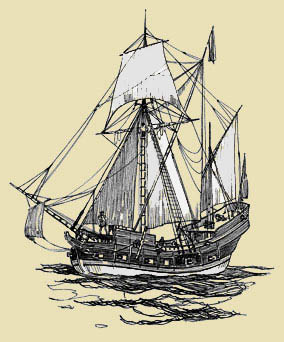The Atlantic Crossing.
It took an adventurous and hopeful spirit to cross the icy seas of the North Atlantic in the 17th century. Our ancestors left everything they knew behind to embark on a voyage which was fraught with danger, only to face the uncertainties of life in the New World.
Making Ready.
Many would depart in small vessels owned by merchants. Some of these ships were built in Rochefort, and when the work was done men on shore pulled them down the Charente River to take on passengers in the port at La Rochelle along the Atlantic coast. Among our ancestors who left from that port were: Jean-Baptiste Bourgery and his wife Marie Gendre; Pierre Perras; Suzanne Rocheteau; Louis Robert dit Lafontaine; Catherine Forestier; Barbe Ménard; Jeanne Petit; and Marie Riton.
Between voyages the ship would be careened in port to effect any necessary repairs to the rotted planks on its leaky hull. To reseal it, the hull was coated with pitch and tar.
Barrels of stone were loaded into the hold along with the cargo and carefully placed to act as ballast. They were well secured to insure they did not break loose and roll around in rough seas. Even as casks of fresh water and wine were consumed during the journey they would be refilled with salt water to maintain the proper distribution of weight needed to keep the ship stable.

from 42 feet to the larger 163 foot
man-o-war. A smooth crossing was more
likely in in one of the king's man-o-wars,
while the flutes and frigates, with a
shallower draft, fated the passengers
to a continuous rolling motion.
océan Atlantique.
When finally the winds were favorable for a crossing the captain raised a flag on the topmast to signal to the passengers on shore that he was ready for the journey. At full sail, with good winds, the ship could traverse the 3,000 plus miles at a speed of 7-8 knots. Hitching a ride in the north-easterly moving waters streaming up from Florida shortened the time for the voyage home but sailing to Québec, against the flow, could take anywhere from 6 weeks to a few months. The ships sailed in the summer, often leaving France in June and returning by October. The rest of the year the ocean served up treacherous icebergs and gale force winds to the travelers.

were able to gauge the
altitude of the sun without
the danger of staring into
its bright light.
Sailing along the recommended course at about 45 degrees latitude led them to les Grands Bancs de Terre-Neuve. But the warm waters streaming up from the Gulf of Mexico which coaxes cod to the Banks also brews a soupy fog when it collides with the cold arctic air. For navigators like our ancestor Pierre Petel who relied upon the sun and the stars, or points on shore, the fog made navigation next to impossible. Running aground, or worse, colliding with another ship, was not unheard of. Sounding lines were used to measure the depth of the ocean as they neared shore. Sometimes they added a bit of tallow to the lead weight attached to the line before it was dropped over the side. As the lead touched the bottom samples of sand or pebbles adhered to the fat which gave further indication of their location and helped stave off disaster.
The Passage.
Canvas draped from the rafters cordoned off the passenger's accommodations in the stern where they slept on bunks stacked up to three high. Even though space onboard was at a premium room was allocated for the horses, cattle, pigs and chickens that were needed in the New World.
Fresh water was too precious for washing clothes leaving passengers wearing the same outfit until the end of the voyage. Even so the water soon became putrid over the course of time.
Meals often included hard tack. Protein could be had from the salt pork, boiled meat or fish, or dried peas or beans that was served a couple times a week, but fruit and vegetables were lacking. The deadly disease scurvy plagued many a traveler due to the lack of vitamin C in their diet.
In addition to drinking water stored in casks, a measure of wine, often from Bordeaux, was proffered to quench thirst. For those who dined at the Captain's table the foods were fresher, but this privilege was available only to those in the upper classes. Even in the close quarters each kept to those in his own social class.
Sanitary conditions were lacking, the toilet being the sea or sloshing chamber pots. The poor diet, lack of proper hygiene, and threat of disease brought on board and spread by an unwitting traveler presented another danger. By some estimates, about 10 per cent of the passengers did not survive the crossing.
- Proulx, Gilles, Between France and New France, Life Aboard the Tall Sailing Ships, Toronto: Dundurn Press Limited, 1984
- Clip art images
